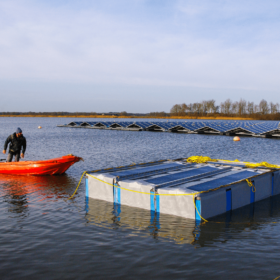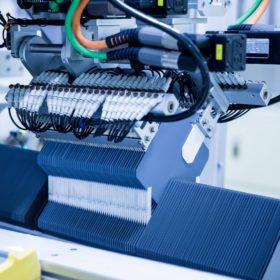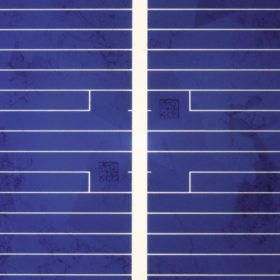A flexible approach to offshore solar
Scientists in the Netherlands are trialing a floating solar installation based on flexible thin-film PV modules. The idea behind their concept is that such modules, in combination with a newly designed flexible racking system, will create a system able to roll with the movement of the water, rather than attempting to defy it.
Manufacturing industry seeks unity on wafer size
Seven solar manufacturers, including tier-1 players, have signed up to a joint initiative aiming to establish a new standard size for silicon wafers at 182mm x 182mm. Conspicuously absent from the initiative is China’s Zhonghuan Semiconductor, which last year introduced a 210mm solar wafer, the largest seen in the industry so far.
New chemistry promises better lithium sulfur batteries
Scientists in the U.S. have developed a new cathode chemistry for lithium-sulfur batteries, which they say promises to overcome performance issues stemming from sulfur’s low conductivity and tendency to react with lithium.
The weekend read: Pirates of the PV industry
Product piracy is a well-known threat in many industries, and in solar the risk posed by poor quality products from disreputable manufacturers making their way onto rooftops and other PV installations should not be underestimated. With manufacturers investing in solutions to protect against inferior products bearing their logo, pv magazine looks at the size of the problem.
Graphene doping a step forward for sodium batteries
Scientists at Switzerland’s École Polytechnique Fédérale de Lausanne (EPFL) have developed an anode from graphene doped with sodium, which they say could potentially overcome some of the fundamental issues in increasing storage capacity and the lifetime of sodium-ion batteries.
Scientists in China give flexible perovskites a backbone
A team of researchers led by Nanchang University in China trialed a polymer based hole transport layer to flexible perovskite solar cells, using a glue to attach it to the active perovskite. The team was able to assemble the 19.87%-efficient cells into a small flexible module suitable for wearable solar applications, and says its design was inspired by the structure and movements of human vertebrae.
A window of opportunity for new transparent electrode
Scientists in Australia have developed a new transparent conductive oxide which could be used in solar cells, smart windows and other applications. The material is indium free and recyclable, according to the researchers.
Another billion-dollar quarter for JinkoSolar
Despite the challenges to both the manufacturing and shipment of its products during the period, JinkoSolar today reported that it shipped 3.4 GW of modules in the first quarter of 2020, bringing its revenue for the quarter just over the billion dollar mark.
A long way to go for iron pyrite solar cells
A paper from Sweden has attempted to uncover why the conversion efficiency of solar cells based on cheap, abundant iron pyrites continues to languish below 3% despite the apparent optoelectronic promise of the material.
A closer look at graphene electrodes
Scientists in the United States have found several shortcomings in the approaches commonly used by scientists to model the structure of electrodes. The group outlines a new approach which it says could lead to the discovery of new materials and combinations that can lead to batteries performing better for longer.











